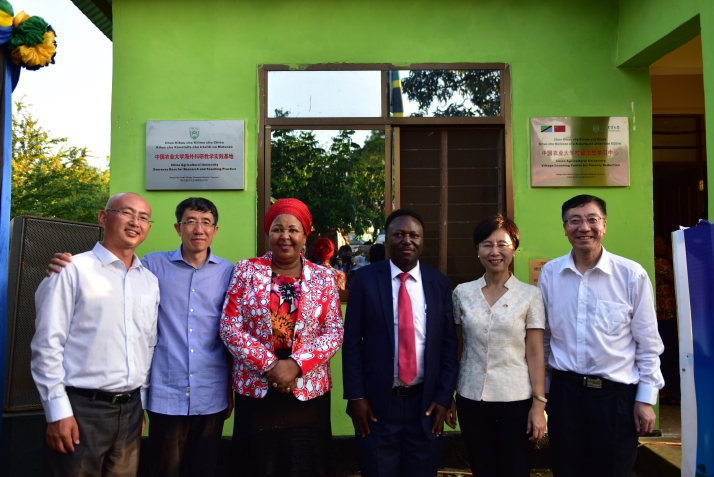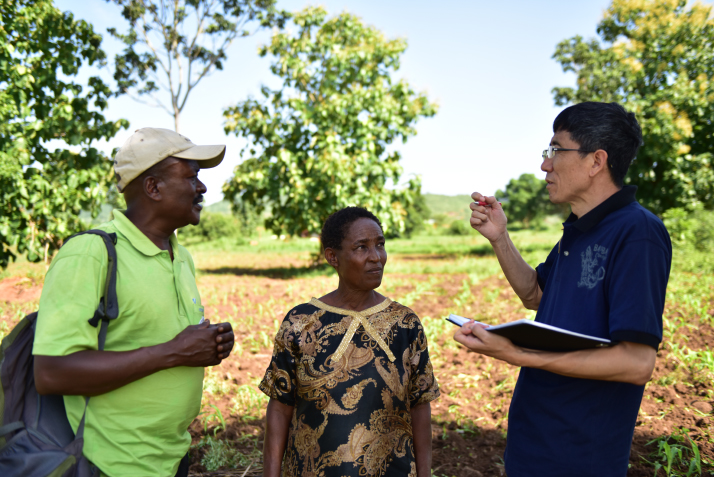|
||||||||||
| Home Nation World Business Opinion Lifestyle ChinAfrica Multimedia Columnists Documents Special Reports |
|
||||||||||
| Home Nation World Business Opinion Lifestyle ChinAfrica Multimedia Columnists Documents Special Reports |
| ChinAfrica |
| An agricultural professor devotes his life to eliminating poverty in China and Africa |
| In Hebian, a village 40 km from the border town of Mohan in Yunnan Province, Li proves the feasibility and effectiveness of his rural development theory. |
| By Xia Yuanyuan VOL. 13 JULY 2021 ·2021-06-25 |

A swarthy face with bright piercing eyes behind a pair of glasses, thin, tall and a little hunched - these are all sequelae of devotion to frequent fieldwork.
For the past two decades, Li Xiaoyun, a professor at China Agricultural University (CAU), has devoted himself to eliminating poverty in both China and Africa's rural areas.
This year, China announced a "complete victory" in its fight against absolute poverty. Li was one of the 1,981 people recognized as anti-poverty role models for his life-long devotion to reducing poverty in rural areas.
However, as a teenager growing up in a small town in Shaanxi Province, he didn't dream about working in the agricultural field. "I wanted to become an artist and musician," Li told ChinAfrica.
At that time, the government used to assign majors to students. At the age of 15 in 1978, Li was assigned to study agriculture in Ningxia Agricultural College. In 1987, he completed a PhD in crop physiology at CAU.
"Before I studied agriculture, I didn't know anything about crops and I had no idea about farming," Li said. But during his studies, he developed great interest in the subject and now he acknowledges that his current career gives him utmost satisfaction as he can help the poor with his knowledge.

A deep exploration
In 1989, Li was invited by CAU to attend a project to help famers find methods of development in a village in Hengshui, Hebei Province, where he established the first demonstration site for promoting agriculture through science and technology.
He and his colleagues brought high-quality shelf cattle from Inner Mongolia Autonomous Region, and raised them locally. They also built a chicken farm, hoping to promote the development of local animal husbandry. It was his first time to work in a rural setting, which enriched his understanding of agriculture and rural areas, and also pushed him to a brand new path.
In the early 1990s, he went to Germany and the Netherlands to study the development modes of these two countries. Based on his study in these countries, Li re-examined the problems of rural development and poverty alleviation in China, which prompted him to introduce development research into China.
After returning to China, Li began to rethink rural issues, focusing on rural revitalization and poverty alleviation in Hebei, and on the field of development research.
In 1994, Li published Guide to Rural Development Planning, a book that systematically introduced the methods of "participatory development" and is considered the beginning of the practice in China.
"The so-called 'participatory development' is to understand who the main target of development is," said Li. In his view, in the development of rural areas, farmers should be placed at the center.
Hebian experiment
In Hebian, a village 40 km from the border town of Mohan in Yunnan Province, Li proved the feasibility and effectiveness of his rural development theory.
When Li visited the village in 2015, what he saw were dark wooden homes, old and worn-out bedding, rickety furniture and people living with their livestock under the same roof.
At that time, Hebian Village had 57 households and 206 people, the majority of whom were from the Yao ethnic group. It was a very poor village with more expenditure than income. In 2015, the per-capita disposable income of villagers was 4,303 yuan ($677) per year. Almost half of the villagers relied on income from growing rice, corn and sugar cane, crops that are susceptible to extreme weather. At the same time, the total cash expenditure per capita was 6,755 yuan ($1,062). Many families went into debt to make ends meet.
Together with teachers and students from CAU, Li initiated a project that empowered the villagers to improve their living environment, a precondition for the development of tourism industry.
Between 2015 and 2017, Li's team raised about 3 million yuan ($471,700) to help the villagers build new homes with the traditional Yao style, each with a guest room, toilet and kitchen. A conference room with a capacity of 50 people was also constructed in the village.
A cooperative was established to manage the tourism industry, and the CAU students taught cooperative members how to use computers for registering guests and issuing invoices.
Li attaches great importance to the "sense of participation" of the villagers. He communicates with the villagers, listening to their opinions and encouraging them to have a try boldly, not to be afraid of making mistakes. He believes that the village belongs to the villagers, and the houses are ultimately used and maintained by the villagers, and his team cannot impose their will on the villagers.
The beauty of the location attracted a stream of tourists and conference goers. Some villagers gave up farming completely and engaged in tourism, while others were taught to cultivate plants that could be used for traditional Chinese medicine. Some became chicken, pig and fish farmers.
The two approaches have helped villagers shake off poverty and have significantly raised their incomes. Most households had an annual income from 60,000 ($9,423) to 70,000 yuan ($10,994) in 2019, with the per-capita income of the village increasing to over 30,000 yuan ($4,712).
Li called the project at Hebian Village an experiment in both poverty alleviation and rural revitalization.

Seeding in Africa
Li and his team also helped farmers in Tanzanian villages overcome poverty.
Located in eastern Africa, Tanzania is a country where agriculture plays a dominant role in the economy and 68 percent of Tanzania's work force are engaged in farming, both in rural and urban areas. However, almost half of Tanzania's population lives below the poverty line of $1.9 a day, predominantly in rural areas, according to the Food and Agriculture Organization of the United Nations.
"If the development of agriculture was not prioritized, the country could hardly achieve poverty reduction and economic growth," Li said.
In 2011, the International Poverty Reduction Center in China launched an aid project in Tanzania, in which Li and his team played a major role. They introduced simple maize planting techniques in Peapea and Mtego Wa Simba villages.
Like China of three decades ago, Tanzania lacks capital but is rich in labor resources, which Li said is an advantage when developing intensive farming.
"In the pilot program, we primarily encouraged farmers to increase the density of the planting area," Li said. "Before we came here, they only grew about 22,500 plants per hectare. Now the number has increased to more than 50,000."
With increased intensity, more villagers are now engaged in labor-intensive farming, greatly increasing yields without using synthetic fertilizers, which are not widely available in Tanzania.
"Eliminating poverty and achieving sustainable development is the common goal and historical task of the Chinese and African people," Li told ChinAfrica. "Exchanges and cooperation in the field of poverty reduction are an important way to promote the sharing of China-Africa development experience, achieve common development, and build a closer China-Africa community with a shared future."
(Print Edition Title: A Pioneer in Poverty Reduction)
Comments to xyy@chinafrica.cn
| About Us | Contact Us | Advertise with Us | Subscribe |
| Copyright Beijing Review All rights reserved 京ICP备08005356号-5 京公网安备110102005860号 |